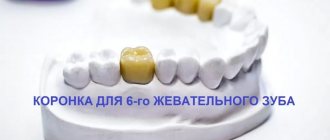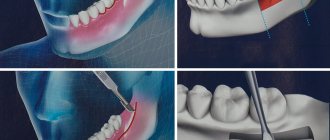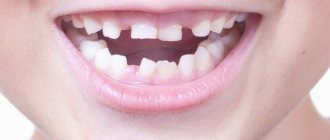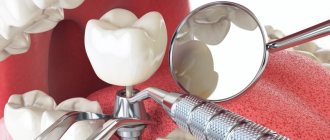The upper jaw is exposed to less chewing load than the lower jaw. Therefore, the bone here is thinner and looser, which complicates the installation of implants. However, if the manipulations are performed correctly, the probability of implantation success is quite high. According to statistics, the average survival rate of implants in the upper jaw is 96-97%. A higher result (99%) is demonstrated by basal implantation with immediate loading, slightly lower results (96-97%) with the classical two-stage technique.
What are the features of upper teeth implantation?
1. After tooth loss, the bone tissue of the upper jaw atrophies (that is, decreases in volume) faster than the lower jaw. Already after 5-6 months, most patients are diagnosed with acute bone deficiency at the sites of defects.
2. Due to the fact that the upper jaw bone is loose, implants “fuse” with it longer. If on the lower jaw the systems take root on average in 2-3 months, then on the upper jaw - in 3-4.
3. Implantation of the upper chewing teeth requires special care, since the maxillary sinuses are located in close proximity to them. Accidental puncture of the sinus threatens the development of infectious complications.
4. When implanting the anterior teeth of the upper jaw, the doctor should pay increased attention to aesthetics. After all, these teeth are responsible for the formation of a smile.
How does implant healing occur?
After implantation, the bone tissue fuses with the implant, which ensures reliable attachment of the artificial root to the jaw bone. The process is called "osseointegration". Occurs in several stages:
- In the first month after implantation, trabeculae of spongy tissue form between the artificial root and the jaw bone tissue. The bone is soft, so the structure is not firmly attached and can be easily damaged if overloaded.
- By the fourth month, dense lamellar bone is formed and fills the free space. The implant is securely fixed, so it can already be loaded with crowns.
- After a year and a half, the structure completely fuses with the bone.
Expert opinion
Vladimir Aleksandrovich Voznyuk
maxillofacial surgeon, implantologist
Experience: more than 33 years
In whatever area of the upper jaw a “gap” is formed - frontal, lateral or chewing - a negative impact on the body is inevitable. The fact that the absence of a tooth is not noticeable from the outside is not an argument in favor of refusing restoration. Decreased quality of chewing function, malocclusion, increased load on neighboring teeth, and as a result - their rapid destruction - these are just some of the problems that will become obvious in the near future. Implantation of teeth in the upper jaw will stop bone atrophy, ensure normal chewing and consumption of any usual food, and prevent early aging of the face. When planning implantation, it is important to choose a reliable clinic and specialist who will individualize the approach to the problem and propose a protocol that is optimal for you.
Gum contour.
A very important point in implant prosthetics is maintaining the gum contour. If an inexperienced implant surgeon misses this point, then the patient’s dissatisfaction may begin to express itself due to aesthetic complaints: the gums around the implant are blue, there are no gingival papillae, and they play a big role in the aesthetic component. To the point that over time (can happen in a very short time) the patient develops a problem with gum loss (gingival recession) and exposure of the implant neck. In our Es-Dent dental center, according to indications, close attention is paid to gum plastic surgery. If an implantologist says that a procedure with the gums is necessary, you should not ignore this stage of treatment in order to avoid problems after the installation of the prosthesis.
Why there are problems with gums.
- A person may naturally have thin gums. Its ideal thickness is 5 millimeters. If the patient’s skin is twice as thin, then one can definitely expect poor-quality aesthetics after prosthetics (if appropriate therapeutic measures are not taken). This will be, at a minimum, unsightly, and at maximum, it will lead to exposure of the implant.
- Attached gum. There may be a deficiency of this type of gum. Ideally, the gums should grow tightly together with the periosteum - this is the attached gum. But the second type is mobile. The results of ignoring gum surgery are the same as with the thin biotype.
The graft for gum plastic surgery is taken from the patient himself in certain places in the palatal space.
Implantation options for small defects in the upper dentition
In the absence of 1-3 consecutive teeth, patients are recommended to receive classical implantation. This is the only technique that allows you to work in a limited volume of bone.
The procedure is carried out in two stages:
- At the first stage, the doctor peels off the gum flap and forms a bed in the bone with a special tool, in which he places the root part of the implant. The gum is sutured. Next, the doctor and patient wait 3-4 months for the structure to take root—during this time, bone cells penetrate the pores of the implant and literally fuse with it.
- In the second stage, the gums are reopened. A gum former is installed on the artificial root, which helps create a beautiful contour of the soft tissue around the neck of the implant. After 2 weeks, the former is replaced with a supragingival head (abutment), on which the crown is fixed.
In total, classical dental implantation in the upper jaw takes about six months.
Important note: if the results of the examination reveal that the patient has bone atrophy, he undergoes an additional procedure before implantation - bone grafting. As a rule, after such an operation, another 3-6 months must pass before the bone volume is restored and becomes suitable for the installation of implants.
Complications and side effects
Implantation is a surgical procedure and carries a risk of complications. Side effects can occur within a few days or weeks, or after 2-3 years.
The following factors can provoke the development of complications:
- Chronic diseases.
- Insufficient examination, inaccurate history taking and incorrect diagnosis, which led to the failure to identify existing contraindications.
- Mistakes made by the implantologist during surgery.
- Neglect of the patient's advice on care.
Immediately after implantation or within a short time, the following complications may begin:
- Painful sensations . Occurs after the anesthesia wears off. A normal reaction is the persistence of painful sensations for no more than three days, during which analgesics can be taken. Prolonged pain may indicate inflammation or nerve damage.
- Swelling. A normal reaction to a violation of the integrity of oral tissues. It appears a few hours after surgery and disappears after 5-7 days. If it persists for more than a week, it may be a symptom of soft tissue inflammation. To reduce swelling, it is recommended to apply cold to the injury site.
- Some bleeding in the first few days is normal. May be caused by taking medications that reduce blood clotting. Severe bleeding or minor bleeding that does not stop for 10 days is a sign of damage to the blood vessels, which is dangerous due to the formation of a hematoma, suture dehiscence, or suppuration.
- Temperature increase . An increase in temperature to 37-38°, observed within three days, is considered normal. Prolonged fever is a sign of an inflammatory process.
- Seams coming apart . Happens due to:
- mechanical damage;
- improper suturing;
- inflammation.
A few months after surgery, the following may occur:
- Peri-implantitis is an inflammation of the jaw bone around a dental structure. Peri-implantitis develops for the following reasons:
- trauma to the wall of the nasal cavity;
- development of bleeding over the plug, causing hematoma and suppuration;
- making a mistake when closing a postoperative wound;
- incorrect technique for forming a bed for the implant;
- inflammation that has developed in a neighboring tooth;
- allowing for inaccuracies in the manufacture of the prosthesis;
- failure to comply with hygiene rules by the patient.
- peri-implantitis;
- insufficient bone volume;
- excessive bone damage during implantation;
- exacerbation of chronic diseases;
- allergy to the rod material;
- smoking;
- temperature damage to jaw tissue;
- osteoporosis of the jaw.
Implantation options for medium and large defects
If there are a large number of missing teeth, classical implantation becomes impractical. Firstly, due to the high level of trauma, the risks of intervention increase many times over. Secondly, such treatment is expensive for patients. Therefore, patients are recommended methods of one-stage implantation of the upper jaw, which reduce the number of surgical procedures and avoid the procedure of bone augmentation:
- Basal implantation .
It is used in the absence of 3 or more missing teeth in a row (including a completely toothless jaw). The essence of the method is that implants are installed in the deepest and densest layers of the jaw, which do not thin out over time. As a result, the systems are firmly and securely attached to the bone. During basal implantation of the upper teeth, the gums are minimally injured, since the implants are screwed in without incisions, through small punctures. Already 3 days after the operation, a fixed prosthesis is fixed on the implants. Along the edge of the prosthesis there is an acrylic gum, which hides the imperfections of the patient’s own mucosa and provides a good aesthetic result. Due to its lightness, the design does not interfere with the normal healing of implants. Almost immediately after prosthetics, the patient can chew food fully. - Methods ALL ON 4 or ALL ON 6.
Indicated for moderate bone atrophy in the patient and complete absence of teeth. Only 4 or 6 implants are installed in a toothless jaw. Of these, two are vertical, in place of the front teeth, the rest are in the lateral areas of the jaw. This approach allows you to bypass the most atrophied areas and fix the implants where more bone is preserved. Prosthetics are performed on the same day or 2-3 days after surgery. Patients are fitted with the same fixed prosthesis as with the basal implantation method.
The doctor selects a suitable implantation technique in the absence of upper teeth based on the results of an examination and computed tomography.
How to properly care for your mouth after surgery
Within 3 days after implantation, the oral cavity is carefully looked after:
- The impact on the implant (chewing load) is excluded.
- On the second day after implantation, you can carefully brush your teeth, avoiding contact with the sutures.
- As prescribed by the doctor, mouth rinsing with antiseptics after meals and anti-inflammatory baths are carried out.
- For two days, cold must be applied to the cheek on the implant installation side for 20 minutes every half hour.
- Avoid sports and excessive physical activity.
- Give up alcohol and cigarettes.
- Eat only food that is thoroughly crushed to a puree state and chewed on the side parallel to the surgical intervention.
- Avoid climbing to heights and flying in an airplane.
- You need to blow your nose and cough carefully, without opening your mouth or puffing out your cheeks.
- Avoid hypothermia and overheating.
- After a sinus lift, you should not drink through a straw.
- If you notice any suspicious symptoms, consult a doctor.
Within 14 days from the date of surgery, oral care involves:
- When brushing your teeth, you should try not to touch the implant.
- After eating, rinse your mouth and take baths.
- Remove food debris from hard-to-reach areas with dental floss.
- Eliminate solid foods.
- Do not chew on the side where the implant is installed.
- Food should be soft in consistency and contain large amounts of minerals and vitamins.
- Avoid excessive physical activity.
- Avoid hypothermia and overheating of the body.
- Cough, sneeze and blow your nose gently.
- When performing a sinus lift, you should not drink through a straw.
- Visit your dentist regularly for checkups.
Regardless of the time that has passed since the operation, it is necessary to carefully care for the implant:
- Use dental floss and brush.
- Use an irrigator or rinse aid.
- Have it professionally cleaned at least twice a year.
Stages of implant installation
- Preparing for treatment .
On the first visit, the doctor examines the oral cavity and talks with the patient. Possible treatment options are discussed. If there are no obvious contraindications to implantation, the patient is sent for a computed tomography (CT) scan and sometimes additionally for a blood test. - Treatment planning.
CT data is loaded into a special program that recreates a three-dimensional model of the patient's jaw. Based on this information, suitable implant models are selected and their installation locations are determined. A surgical template is then created in the laboratory using the 3D model to be used for the operation. - Implantation of upper teeth.
Under local anesthesia, through incisions (with the classical method and ALL ON 4/6 methods) or through small punctures (with the basal method), the implants are implanted into the jaw. - Prosthetics .
Depending on the protocol used, the dentures are fixed on the implants for 2-3 days or several months later.
Prosthetics of the lower jaw on implants
The structure of the lower jaw is different - the bone mass is denser and thicker, the installation of a lower prosthesis in the absence of teeth, and the implantation of implants have other features.
“All on 4” protocols, as mentioned earlier, in most cases allow for complete restoration of teeth. The healing process is faster - the vast majority of patients forget about the presence of artificial teeth after three months. This is possible due to the increased density and sufficient height of the bone. The method is recommended for lack of volume (short length, thickness), atypical location of the mandibular canal.
Example #4 - All on 4 implantation with lower jaw prosthetics
Our patient is 82 (!) years old
. For the last 10 (!) years I have been trying to carry out treatment - restoration of the dentition with the help of implants. But, unfortunately for him, it was not successful - the implants were lost for a number of reasons - they did not take root, they became inflamed. But we must give our patient his due - he did not lose hope. A man of very progressive thinking, he understood that the problem was not in his body, but that something else was happening that was preventing him from becoming the happy owner of a high-quality denture on implants.
The result of “All on 4” prosthetics is presented in the photo below:
More details about this interesting clinical case can be found HERE.
Cost of implantation of upper teeth in Moscow
The cost of implantation depends on the clinic, the type of implants and the patient’s situation. On average, the price for installing one implant varies from 30,000 to 60,000 rubles. Complete jaw implantation will cost 200,000 - 400,000 rubles.
ROOTT centers support an affordable pricing policy. The cost of installing one classic implant (two-stage protocol) in our clinics is 32,000 rubles. The production of a crown is paid separately (from 28 thousand rubles).
Implantation of more than 3 upper teeth using the basal protocol will cost an average of 80,000 -110,000 rubles. And the price for a complete restoration of the dentition will be 265,000 rubles - this price already includes the required number of implants, X-ray diagnostics, doctor’s work and a fixed prosthesis.
Which implants are better for complete edentia?
The quality of dental implants is evidenced by their place in the ranking of popular dental products. The leading positions in such ratings remain with titanium rods manufactured in the USA and European countries.
The most popular dental structures in the world are Swiss Nobel Biocare and Straumann, American 3i Biomet, Zimmer and BioHorizons, Swedish Astra Tech.
In Russia, among the participants in these ratings, implants from Astra Tech, Straumann, and Nobel Biocare are the most in demand.
Where to go for upper jaw implantation in Moscow
The main feature of dental implantation in the upper jaw is its structure. The bone here is more porous and susceptible to the rapid development of atrophic processes after tooth extraction. The algorithm for installing implants in the maxillary bone often requires a preliminary sinus lift.
After administering local anesthesia, the surgeon makes an incision in the gum, exposes the bone and prepares the implant bed. At this stage, the implantologist must have great intuition and experience. The next step, that is, installation of the implant, determines the success of the procedure. Finally, the implant is closed with a closure or healing screw, or a temporary prosthesis is placed on it. If the procedure was performed under local anesthesia, the patient can go home after a short time. If the anesthesiologist has performed sedation, he decides how long the patient will be monitored in the clinic. Usually this is no more than half an hour.
The choice of dentistry for dental implantation of the upper jaw is extremely important, because the final result depends on the experience of specialists and the level of equipment of the clinic. The approximate cost of this dental service in Moscow clinics is given in the table below.
| Name | Clinic address | Service cost |
| ROOTT |
|
|
| Shandora | Moscow, Kolpachny lane, 6, building 4. |
|
| Dentistry Grand Smile | Moscow, st. Miklouho-Maklaya 43 (metro station Belyaevo, Yugo-Zapadnaya, Kaluzhskaya) | Prices for dental implantation from 30,000 rubles (MIS system) to 70,000 rubles (Nobel) |
| Dentistry City Dent | Moscow, st. Novocheremushkinskaya, 57 | Implantation of one tooth with the Astra Tech system – 52,000 rubles |
| Dentistry Vita-Stom |
| Implantation of one tooth with the Straumann system (Switzerland) – from 32,000 rubles. |
The first two weeks after surgery, during which tissue healing occurs, are key to the success of the overall treatment, regardless of whether you had your front teeth restored or your posterior upper teeth implanted. At this time, it is very important to follow the doctor’s recommendations:
- For 7-10 days, the implant area must be washed with saline solution after each meal to maintain proper cleanliness.
- If during the first 2 weeks the patient experiences discomfort when using dentures (excessive pressure), it is necessary to contact the dentist to adapt the dentures to the anatomical conditions of the oral cavity.
- After the procedure, it is recommended to eat only liquid and semi-liquid foods.
- Bruises and hematomas are not a cause for concern; they are a common complication that does not require additional treatment.
Other jobs
How to speed up the healing time of implants
Osseointegration is a physiological process, the speed depends on the condition of the patient’s bone tissue, the implantation method, and compliance with recommendations. But to protect yourself from unwanted rejection, you need to take care of this in advance:
- choose a clinic carefully - you should contact trusted institutions based on recommendations from friends after carefully studying the site and available information;
- contact a qualified doctor - you cannot go to a private specialist who does not officially work in the clinic, you should ask him for certificates, look at photos of examples of work;
- do not refuse preliminary preparation and diagnosis - a qualified doctor will insist on this stage;
- choose high-quality implants - preference for companies that have been presenting products on the market for at least 10 years;
- find out the warranty period and service - the nuances should be clarified before the procedure;
- check compliance with sterility and safety - clinics with a good reputation should work according to the Anti-AIDS-Anti-Hepatitis program.
Examples of work “Before” and “After”
Restoration of all teeth on the upper and lower jaw - basal implantation
Case: partial absence of teeth on the upper and lower jaw, complicated by severe periodontitis (tooth mobility).
Restoration of the upper jaw - basal implantation (March 2012)
Case: partial absence of teeth in the upper jaw, the remaining teeth are mobile and cannot be restored.
Restoration of the upper jaw - basal implantation
Case: the patient came to the Simpladent clinic with complaints of a fracture of teeth under a metal-ceramic structure and mobility of the latter in the upper jaw.
Basal implantation in case of complete absence of teeth in the upper jaw
Case: partial absence of teeth in the upper jaw, the patient also complained of mobility of the bridge, the remaining supporting teeth were destroyed.
Reasons for missing teeth
1-2% of the population has a genetic disorder in which teeth are initially absent or their number is abnormally small. In the vast majority of cases, the absence of lower or upper teeth is a consequence of illness or mechanical damage. Doctors at the clinic name the main reasons:
- Untreated caries or pulpitis. Tooth tissues are destroyed, in advanced cases, inflammatory processes in the gums begin, and the bone structure changes. Our dentists try to preserve every unit. But, if the process is already irreversible, then it is necessary to remove one tooth or several.
- Inflammatory processes in periodontal tissues lead to the fact that the ligament cannot hold the tooth in the socket. The crown becomes loose, destructive phenomena progress, and the gums and bone are destroyed.
- Injuries. The complete absence of teeth or partial adentia is caused by dislocations, bruises, fractures of the tooth crown or root, and other damage resulting from mechanical impact.
Sometimes teeth can be lost after suffering from somatic diseases: oncological, endocrine, and others that weaken the immune system and affect the structure of tissues.
Top brands
Global implant manufacturers often produce brand lines with different diameters and lengths. This allows you to choose the most suitable option for a particular patient, taking into account the structural features and condition of the maxillary tissues. Popular brands:
- Nobel Active (Nobel company, USA) - high-quality titanium roots with a minimum diameter and long enough to reach the basal layer of the jaw tissue; have a special coating that speeds up the implantation process; installed on the front teeth, provided there is a sufficient amount of gum tissue;
- PURE (Straumann company, Switzerland) – zirconium implants, beautiful and durable, coated with a composition that makes the roots take root better; suitable for any units of the dentition;
- Bone Level Tapered Small One (Strauman) – implants made of ultra-strong material Roxolid with a minimum diameter; ideal for the smile area of the upper jaw, even with slight atrophy of bone tissue;
- Bone Level Tapered (Straumann) – also Roxolid material, diameter and length are different; in the smile area, implants with a small diameter and sufficient length are used to penetrate the basal layer, on chewing units - standard ones; a feature of this design is its manufacturing technology, as a result of which artificial roots take root better;
- Hi-Tec (Hi-Tech company, Israel) – high-quality titanium implants with different diameters; this allows you to select a model for any tooth in the dentition of the upper jaw; The quality is practically not inferior to the Nobel brand, but their price is much lower.
Implants from popular brands
The dentist and the patient decide which brands are best suited in a particular case. The effectiveness of implantation depends not only on the quality and price of the brand, but also on the skill of the implantologist. Even inexpensive models installed by a qualified specialist will take root well in the tissues of the jaw, will last and will be a reliable support for the prosthesis.
PiezoSurgery® - gentle tooth extraction and sinus lift
For pre-implantation preparation, the NSK VarioSurg 3 ultrasonic scalpel is used
- Affects only hard tissues, damage to nerves, blood vessels or sinus lining is excluded
- Does not damage the bone around the teeth during extraction
- Gently works with bone tissue during osteoplasty
What to do if there is not enough bone tissue to implant implants on top
In case of unsatisfactory condition of the bone structures of the upper jaw, a sinus lift procedure (building up the bone to the required volume) is performed before implantation. The essence of the technique lies in raising the bottom of the maxillary sinus and filling the resulting space with biomaterial. The operation can be performed in two ways:
- open;
- closed.
Open includes several stages:
- Gum section.
- Cutting the outer layer of bone using a ball-shaped bur.
- Providing access to the maxillary cavity.
- Gently lifting the bottom of the maxillary sinus.
- Placement of bone material into the resulting space.
- Installation of a protective membrane.
- Stitching.
It takes 5-6 months for the graft to engraft. When the planted biomaterial grows with blood vessels and becomes viable, an implant is implanted into it.
The closed sinus lift technique is indicated for alveolar ridge heights of 7-8 mm. All procedures are performed through a puncture, not a cut. Bone granules are inserted through a miniature hole. The implant is placed immediately after the procedure is completed.
Implantation methods
To restore the upper teeth, we use all known techniques that are suitable for various clinical situations.
- Classic two-stage Includes two stages - implant installation and crown prosthetics. Up to 6 months pass between them, during which time the implant reliably fuses with the jaw bone without load.
- One-stage with immediate loading A temporary crown made of medical plastic is placed immediately after surgery - a new tooth in 1 day. After engraftment, the implant is replaced with a permanent one made of zirconium dioxide.
- Instantaneous after tooth extraction The implant is installed in the socket of the removed root. Treatment time is reduced by 5 months—there is no need to wait for bone restoration after removal.
- Mini-implantation Small implants are used, which are placed even in atrophied bone and take root quickly. Suitable for complete edentia as a temporary solution.
The upper dentition forms a smile to a greater extent than the lower one. Therefore, implantation places high demands on both functionality and aesthetics. If the technique does not involve installing a crown on the implant immediately, a temporary removable orthopedic structure is used during its healing. In any case, you will not leave our Center without teeth.
We work exclusively with premium Nobel Biocare® implants. We use only original prosthetics, which guarantees a long service life of crowns and dentures. We provide an indefinite guarantee for implantation in the LifeTime Warranty format. Since 2004 we have been the Nobel Biocare® Center of Clinical Excellence in Eastern Europe.
Digital diagnostics - to eliminate risks
A Sirona Galileos computed tomograph (Germany) with ENT mode settings is used
- Assessment of bone parameters in the implantation zone, location of the maxillary sinuses
- Analysis of the condition and position of tooth roots during single-stage implantation
- 3D operation planning, creation of navigation templates









